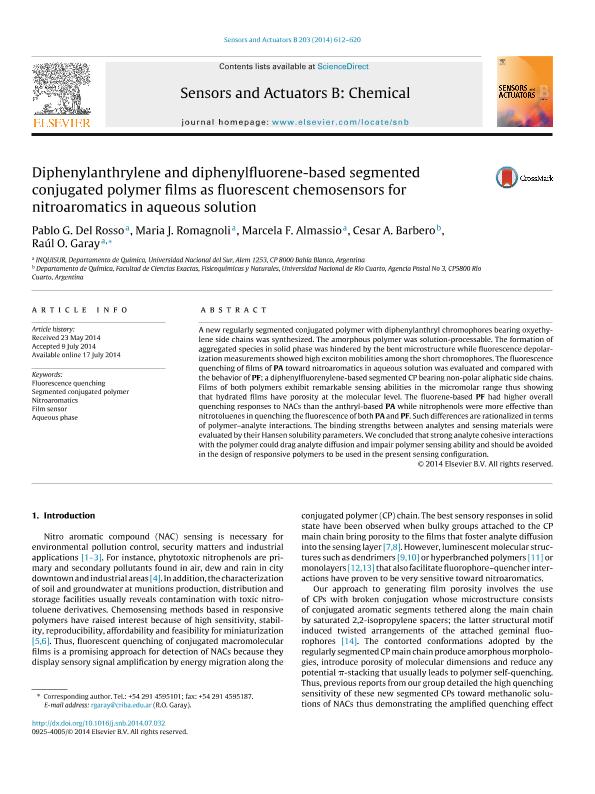Artículo
Diphenylanthrylene and diphenylfluorene-based segmented conjugated polymer films as fluorescent chemosensors for nitroaromatics in aqueous solution
del Rosso, Pablo Gabriel ; Romagnoli, Maria Jose
; Romagnoli, Maria Jose ; Almassio, Marcela
; Almassio, Marcela ; Barbero, César Alfredo
; Barbero, César Alfredo ; Garay, Raúl Oscar
; Garay, Raúl Oscar
 ; Romagnoli, Maria Jose
; Romagnoli, Maria Jose ; Almassio, Marcela
; Almassio, Marcela ; Barbero, César Alfredo
; Barbero, César Alfredo ; Garay, Raúl Oscar
; Garay, Raúl Oscar
Fecha de publicación:
11/2014
Editorial:
Elsevier Science Sa
Revista:
Sensors and Actuators B: Chemical
ISSN:
0925-4005
Idioma:
Inglés
Tipo de recurso:
Artículo publicado
Clasificación temática:
Resumen
A new regularly segmented conjugated polymer with diphenylanthryl chromophores bearing oxyethylene side chains was synthesized. The amorphous polymer was solution-processable. The formation of aggregated species in solid phase was hindered by the bent microstructure while fluorescence depolarization measurements showed high exciton mobilities among the short chromophores. The fluorescence quenching of films of PA toward nitroaromatics in aqueous solution was evaluated and compared with the behavior of PF; a diphenylfluorenylene-based segmented CP bearing non-polar aliphatic side chains. Films of both polymers exhibit remarkable sensing abilities in the micromolar range thus showing that hydrated films have porosity at the molecular level. The fluorene-based PF had higher overall quenching responses to NACs than the anthryl-based PA while nitrophenols were more effective than nitrotoluenes in quenching the fluorescence of both PA and PF. Such differences are rationalized in terms of polymer?analyte interactions. The binding strengths between analytes and sensing materials were evaluated by their Hansen solubility parameters. We concluded that strong analyte cohesive interactions with the polymer could drag analyte diffusion and impair polymer sensing ability and should be avoided in the design of responsive polymers to be used in the present sensing configuration.
Archivos asociados
Licencia
Identificadores
Colecciones
Articulos(CCT - CORDOBA)
Articulos de CTRO.CIENTIFICO TECNOL.CONICET - CORDOBA
Articulos de CTRO.CIENTIFICO TECNOL.CONICET - CORDOBA
Articulos(INQUISUR)
Articulos de INST.DE QUIMICA DEL SUR
Articulos de INST.DE QUIMICA DEL SUR
Citación
del Rosso, Pablo Gabriel; Romagnoli, Maria Jose; Almassio, Marcela; Barbero, César Alfredo; Garay, Raúl Oscar; Diphenylanthrylene and diphenylfluorene-based segmented conjugated polymer films as fluorescent chemosensors for nitroaromatics in aqueous solution; Elsevier Science Sa; Sensors and Actuators B: Chemical; 203; 11-2014; 612-620
Compartir
Altmétricas



